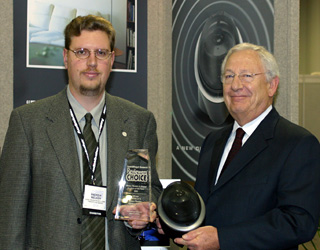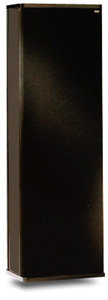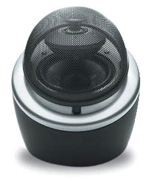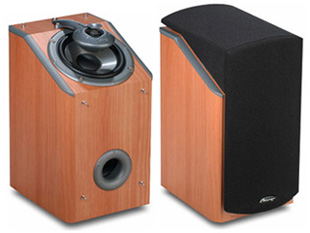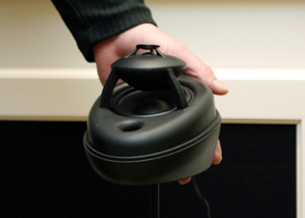![[SoundStage!]](../sslogo3.gif) Getting Technical Getting TechnicalBack-Issue Article |
|||
February 2004
Mirage Loudspeakers, a subsidiary of Audio Products International, has long been recognized as a leader in loudspeaker design, especially with speaker formats. In 1987 they were the first to design a bipolar loudspeaker. This was followed in 1996 with the introduction of their Omnipolar loudspeakers. In 2001 the company created the OmniGuide module, which incorporates patent-pending technology. I had the opportunity to interview Mirage's design engineer, Andrew Welker, who explains the different speaker formats and the ideas behind their creation. There are four basic speaker formats: direct radiating, dipolar, bipolar, and Omnipolar (Omnipolar is a Mirage-trademarked term). The first format, direct radiating, is the most common and conventional. In this design the drivers are arrayed on the front of the speaker, directing sound toward the listening position. The typical sound pattern of direct-radiating speakers is analogous to a diffuse beam of light -- the sound radiates in conical shape in one direction. Direct-radiating speakers generally have poor dispersion since they only provide good sound quality in a small area, or "sweet spot." Andrew Welker explains: "Real-life acoustic events, whether produced by instruments, voices, or jackhammers, do not disperse sound in the same way as a typical loudspeaker. Thirty percent of all sound we hear is the direct signal from a sound source, and the remaining 70% is reflected or reverberant sound. The question then becomes: 'Why do we design loudspeakers to produce the inverse proportion of direct to reflected signal in a typical listening room?'
"Mirage asked that question many years ago at the time the original National Research Council (NRC) loudspeaker studies were taking place. How could a loudspeaker be designed that would mimic the proportion of direct-to-reflected signal produced in nature? The premise was that if we were able to do this, we would be able to achieve a higher level of realism and fidelity when compared to a conventional forward-radiating loudspeaker." This thinking led to the development of Mirage M-1, introduced in 1987, the world's first bipolar loudspeaker. Andrew describes how it works: "A bipolar loudspeaker is simply a configuration of moving-coil drive units mounted on both the front and rear of a cabinet and wired in electrical phase with one another. The result is very much like having two good-quality forward-radiating speakers wired together in phase with one pointing forward, the other backwards. The loudspeaker now begins to disperse sound nearly 360 degrees around the cabinet. This arrangement produces signals identical to a forward-radiating loudspeaker in front of the loudspeaker with the addition of reflected signals off of the rear and side walls due to the sound produced by the rearward-firing driver units. When these signals are acoustically added together in the listening room, we found that we were now achieving very close to that 30:70 direct-to-reflected sound ratio found in real life." "That's fine from a technical standpoint," continues Andrew, "but what did it mean for the listener? First, sounds no longer seemed to emanate from a discrete left or right loudspeaker but from within a soundstage that was wider and deeper than anything we had heard before. Instruments were placed within this soundstage with realistic image definition, which is to say it was not the razor-sharp, pinpoint image specificity that some manufacturers try to pawn off as ‘reality.’ Simply put, these bipolar loudspeakers sounded like nothing else on the market in that they began to produce a sound much closer to reality than ever before." Dipolar speakers are similar to Mirage's bipolar design in that both formats send sound out to the front and back of the speaker. However, dipolar speakers generate sound waves that are out of phase between the front and rear drivers -- this means that as the sound wave is emitted from the front, an inverse sound wave is emitted from the back. Bipolar loudspeakers' sound waves, as mentioned, are in phase. This allows the speakers to produce greater bass response because their low-frequency output is reinforced by the in-phase drivers. Mirage believed they could surpass the bipolar loudspeaker's sound quality and further improve imaging. In 1996 the first Omnipolar speaker, OM-6, was born. Omnipolar speakers emit sound waves in all directions at once and create wider dispersion. Mirage's original Omnipolar configuration consists of a box section above the base that contains the midrange and tweeters on both its front and back. They had improved dispersion at high frequencies -- the common challenge of creating full-range wide dispersion -- by reducing the overall depth of the loudspeaker cabinet. The new OM-6es were, therefore, closer to a perfect 360-radiator at all frequencies. In 2001, after two years of hard work, Andrew took Mirage's Omnipolar design one step further with the new OmniGuide module. "We wanted to create an Omnipolar-radiating loudspeaker in a smaller, more compact package that could be mounted in any position and still produce an enveloping soundfield with the desirable 30:70 direct-to-reflected signal ratio," says Andrew. "The requirement of bipolar technology for front- and rear-mounted drive units limits how small you can feasibly make a loudspeaker and also limits the amount of bass-output capability from a given cabinet volume. The OmniGuide is a patent-pending technology that allows us to achieve a similar overall dispersion to one of our Omnipolar models with only one tweeter and woofer rather than two." "There are two main components that make up the OmniGuide," says Andrew, "and both are crucial to its operation. Firstly, sound waves act in a similar manner to light in that they can be reflected off hard surfaces. A concave- or bowl-shaped surface will tend to concentrate any sound waves hitting it at a point in the center of the bowl while a convex (turn that bowl upside down) surface will disperse sound waves in all directions. Many so-called omnidirectional loudspeakers use this principal to disperse sound in all directions. However, when we began the research study that resulted in the OmniGuide, we discovered that a truly omnidirectional loudspeaker produces a much higher proportion of reflected/reverberant signals in a listening room than occurs in reality. The downside to this is that these omnidirectional loudspeakers produce a large wall of sound with no sense of a defined image, so much so that a solo female voice can sound as if it's ten feet wide! This discovery pointed us in a direction to try and maintain a 360-degree dispersion pattern while attempting to restore an accurate impression of imaging."
"The solution," continues Andrew, "was to combine a convex reflector with the natural radiation properties of a cone mid-woofer at the same time. As the wavelengths of frequencies being reproduced by a driver become small relative to the size of the driver's diaphragm, the dispersion of the driver begins to decrease until such time that it is only radiating from a small point at the center of the driver, otherwise known as ‘beaming.’ We normally sidestep this problem by crossing over to a smaller driver (tweeter) at a frequency where beaming from the driver is not yet occurring. However, even before severe beaming takes place, the driver's natural dispersion begins to narrow. "If you place a single woofer on the front of a cabinet it will radiate predominately in the forward direction at high frequencies with a reduction in the level of these frequencies as we move to the side (off-axis) of the cabinet. If you place a woofer on the top of a cabinet pointing towards the ceiling, you are now listening at 90 degrees off-axis to the woofer, and hence will hear a greatly reduced proportion of high frequencies until you get up out of your listening chair where again the level of high frequencies will increase. However, the signals produced by this top-mounted driver which are not beaming will be evenly radiating at all directions around the cabinet. "Now, think about what will happen if you place that woofer on a surface slanted towards the listener," says Andrew. "You will have some reduction of high frequencies compared to the forward-mounted woofer, but not as severe as the top-mounted woofer. If you move up and down relative to this sloped woofer you will notice a change in the proportion of high frequencies, but again, not as severely as with the top-mounted woofer. What has happened is that we have biased the dispersion of this lone woofer slightly towards the front of the speaker. The horizontal dispersion will be very similar to a forward-mounted woofer but with the benefit of greatly improved vertical dispersion, essentially midway between forward-radiating and omnidirectional! "Now, if we go back to the idea of a convex reflector and place this centrally above the sloped woofer, the frequencies where the woofer is starting to beam will be reflected off of the convex surface and uniformly dispersed 360 degrees around the cabinet. We are actually using the limited dispersion of the woofer at high frequencies to aid in the overall dispersion of the loudspeaker. The same principal is applied to the tweeter, which has its own convex reflector. From a measurement standpoint, the off-axis measurements of a loudspeaker using the OmniGuide will be very similar, both in the horizontal and vertical planes. The confirmation of this is that the total-radiated sound power (an averaging of horizontal and vertical frequency responses measured 360 degrees around the cabinet) is nearly identical to the on-axis response. "There is also another measurement that we perform which very few loudspeaker designers talk about: the directivity index. The directivity index (DI) is calculated from the same series of curves used to produce the sound-power curve and gives us a representation of how a loudspeaker's dispersion varies with frequency. The DI of a loudspeaker using the OmniGuide will be very close to the theoretical ideal: a flat line with very little variation with frequency, suggesting wide dispersion at all frequencies." Since its beginnings in 1972, and with the developing of two revolutionary speaker formats -- bipolar and Omnipolar -- Mirage's latest design is the most flexible and compact speaker to date. An OmniGuide-equipped speaker can be placed almost anywhere within a room, and because its sound dispersion is nearly spherical, the listener can hear high-quality sound equally throughout the room. Andrew concludes: "The OmniGuide is a technology that allows us to create a perceived in-room direct-to-reflected soundfield that is very close to what we hear in reality." And isn't mimicking reality the end goal of all loudspeaker design? ...Alison Aulph
|
|||
|
|||
![[SoundStage!]](../sslogo3.gif) All Contents All ContentsCopyright © 2004 SoundStage! All Rights Reserved |
